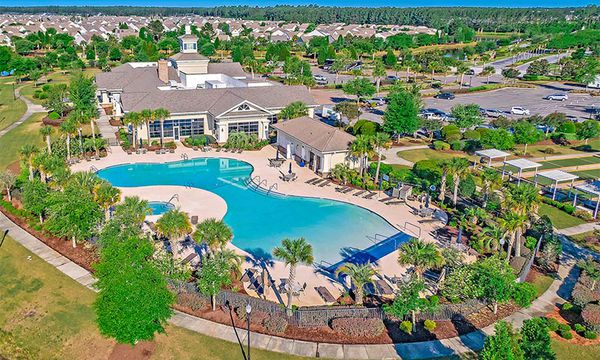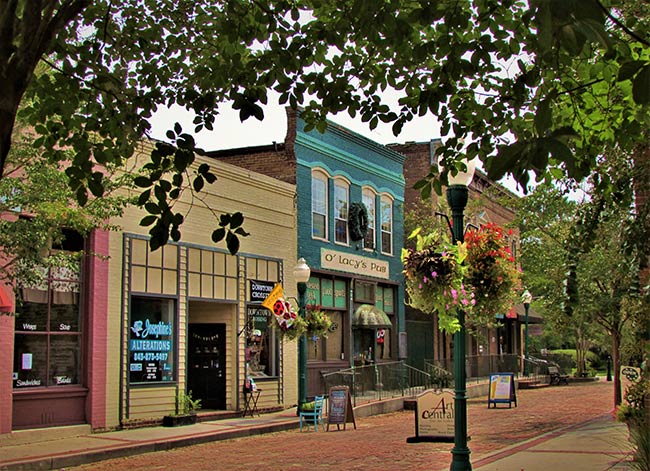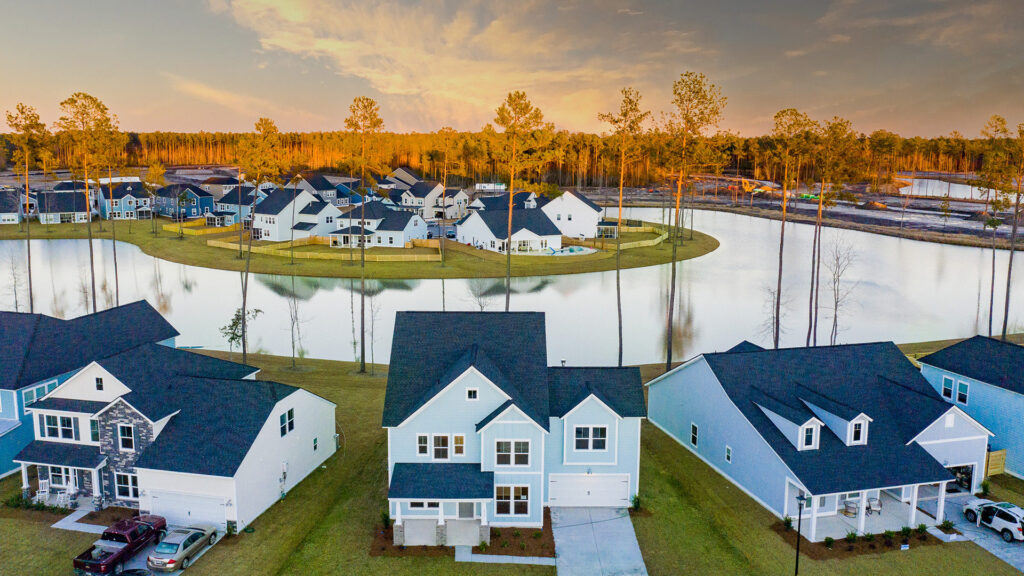HOA Management in Summerville, SC
William Douglas Management is a leader in customer service — the experience and expertise that your association needs and deserves!
Summerville is a town in Dorchester County
Summerville, South Carolina, is a town located in Dorchester County, with small segments in Berkeley and Charleston counties. Summerville’s population per the 2010 U.S. Census was 43,392. The estimated population in 2019 was reported by the U.S. Census to be 52,549. Per the U.S. Census, Summerville has a total area of 18.05 square miles. Latitude: 33°0′29″N, Longitude: 80°10′58″W. The street delivery zip codes for Summerville are 29456, 29483, 29485, and 29486. P.O. Box delivery zip code is 29484. The area codes for Summerville are 843 and 854.
Summerville is located northwest of Charleston. Summerville is approximately 26 miles to Charleston’s Battery or 2 Murray Blvd, Charleston, SC. The town is located in the Coastal Plains region of South Carolina at an elevation of 89′ above sea level. Summerville received its town charter in 1847.
A brief historical overview of Summerville and the surrounding area.
From the beginning of time, towns and cities around the world have had founding’s based on numerous factors. Typically, these origins revolved around nearby natural resources or transportation modes, such as oceans, rivers. In later eras, roads and railroads played a driving force in development. Summerville has a unique place in history, and possibly the only town first settled to escape the pesky and deadly mosquito.
Since early recorded European exploration, the South Carolina Lowcountry has had a high concentration of mosquitos and malaria that many carried. This overabundance of mosquitos has been attributed to the many marshes and poor drainage that affects the region. While at one time malaria affected much of the United States, the Mississippi Delta seemed to be the only region to surpass the South Carolina Lowcountry with malaria epidemics. Malaria was only deemed eradicated in the United States by the widespread utilization of the pesticide DDT in 1951.
Today, malaria is one of the world’s most deadly diseases. Malaria has killed more people than any other vector-borne disease. Malaria has probably killed more people than any other infectious disease in history. Before it was officially eradicated in the United States, South Carolina had 17,357 malaria infections in 1937. In 2005 there were 1,528 malaria cases in the United States; however, the vast majority were deemed to have been imported cases from infected regions of the world.
The South Carolina Lowcountry, from the original settlement of Charles Town (Charleston) in 1670 through the early 20th century, suffered from an overabundance of mosquitos. In the late 1700s, the Lowcountry population was subjected to yearly malaria epidemics. The correlation between the mosquitos and malaria was not proven until 1897 by Sir Ronald Ross. In the Lowcountry, it was a common belief that malaria originated from swamp mist or swamp night air.
In efforts to escape the summer heat and the ever-prevalent mosquitos, the wealthy of Charleston and other Lowcountry areas sought out higher and cooler locations that offered relief. This excessive heat and mosquitos’ period, with the related malaria season, ran from May to October. In the latter part of the 1800s, many of the Lowcountry wealthy would travel all the way to the mountains of North Carolina for relief from the heat and mosquitos.
The legend of the origin of Summerville began with Militia Captain James Stewart, an area rice planter. The story goes while out hunting one summer day, he began chasing game and was forced to make camp when evening arrived. This campsite was located on a ridge seventy plus feet above sea level that was heavily forested with longleaf yellow pine trees. The site with the Ashley River to the southwest and the Cooper River to the east was cool, receiving a steady breeze from the Atlantic Ocean coast twenty miles to the east and south. Surprisingly, the site was free of the mosquitos that plagued much of the Lowcountry. This lack of mosquitos was probably due to the soil being sandy in that area and draining well, thus preventing standing water and mosquitos from laying eggs. Stewart reportedly shared his campsite location with others, and the area became popular for being cool and void of mosquitos. The best estimate is this occurred in or around 1785.

What is known for certain is the area that would become Summerville became a popular area to escape the heat and mosquitos of the Lowcountry shortly after the American Revolution (1775 to 1783). Per newspapers of the era, the name “Summerville” begins appearing in the 1820s. It has reportedly originally referred to as “Pineland Village” or “pine-land village.” This name could have been a specific location, or, during this era, it was common to refer to pine forests as “Pinelands,” so it could have possibly just been a generic reference to a village (settlement) in the pine forest.
From an advertisement in The Charleston Daily Courier, October 11, 1850, edition: “TEACHER WANTED – A Gentleman residing on his Plantation in the winter, and a healthy Pineland Village in the summer, wants a TEACHER, for two Boys; he must be a single Gentleman, a Southerner, and competent to prepare a Boy for College, both in Mathematics and the Languages. Apply to JOHN COLCOCK – Charleston, or JULIUS G. HUGUENIN – Grahamville, P.O.”
The population of nearby Charleston from 1770 to 1850 increased from 10,863 to 42,985 (per U.S. Census). As the population of Charleston increased, so did the summer visitors to Summerville or what would become Summerville. The original structures on the Summerville ridge were described as “roughly built of log planks” summer homes. These original homes were reportedly of similar design and layout and were called “mosquito houses.” The common design characteristics were a broad central hallway with two rooms on each side of this broad hallway. This broad hallway allowed for better airflow and cross ventilation. If there were a second floor, it would typically mirror the bottom floor layout. The structures were also described as “temporary houses” built upon pilings or stilts. Being built up to eight feet above the ground allowed for better and cooler airflow into the home. Historical documents from this era state there were 23 houses in 1828. The settlement was described as deserted during the winter months, which was the case until the early 1830s.
From this advertisement in The Charleston Daily Courier, which granted, liberally utilizes capitalization, references “a healthy Pineland Village” instead of “the” Pineland Village illustrates this point of name usage during this era. However, even if “a healthy Pineland Village” is directly referencing the area that officially became Summerville in 1847, three years before this advertisement, it helps illustrate the origin of the town as the type of location that attracted the wealthy from the Lowcountry escaping the heat and mosquitos during the summer months.
It is said the abundance of pine trees and the absence of mosquitoes is what made Summerville popular, however, it is the railroad that built the town. Summerville was probably America’s first railroad town. A Charleston & Hamburgh Rail Road stop was added in 1835. The arrival of the railroad affected Summerville the way it would eventually have in many areas of the United States. Once the railroad arrived, small villages grew “overnight” into large towns. Desolate, unpopulated areas became populated once the railroad arrived. The increase in year-round or permanent residents in Summerville can be attributed to the arrival of the railroad. As a result, the original temporary summer homes were being replaced with permanent homes.
The South Carolina Canal & Rail Road Company was a holding company that built the Charleston & Hamburgh Rail Road. In 1827, the South Carolina legislature granted a railroad charter to construct a railroad from Charleston to Hamburgh (North Augusta). The work on the railroad commenced on January 9, 1830, at Line Street in Charleston, considered at the time to be on the outskirts of the city. Railroads were relatively new, with the first commercially viable steam locomotive in Leeds, England. In 1812, there was a huge learning curve with the construction of the rail line. Only six miles of the rail line was completed in 1830; however, by October of 1833, the 136-mile rail line was operational from Charleston to Hamburgh.
The South Carolina Canal & Rail Road Company accepted a proposal by E. L. Miller to construct a locomotive engine in New York on March 1, 1830. Miller designed the engine to operate at ten miles an hour and pull three times its weight. Upon trials when delivered to Charleston in December of 1830, Miller’s engine ran at 16 to 21 miles per hour loaded with between 40 to 50 passengers in four or five railcars. The engine, without railcars, operated at between 30 and 35 miles per hour.
Miller’s engine was christened the Best Friend of Charleston. This engine had two distinctions, the first built in the United States and being the first engine to regularly operate, pulling railcars, on an American railroad. Best Friend was in operation for just six months when a rail worker, annoyed by the hissing steam, tied down a pressure safety valve, resulting in the boiler exploding. The engine was rebuilt in Charleston and was rechristened the Phoenix thereafter.

The arrival of the railroad increased the population and permanent housing. These permanent homes were constructed in what was known then as Summerville Village. This area is generally the W. Carolina Avenue, Gadsden Street, and Sumter Avenue area, around present-day St. Paul’s Anglican Church. Many of these original homes can be found there today.
The South Carolina Canal and Rail Road Company purchased a 1,800-acre tract of land and, in 1832, set aside a portion of this tract for a settlement named “New Summerville.” The plan laid out a town along the new rail line that was running southeast to northwest. Running parallel to the rail line were streets. These streets running parallel were the basis of the street grids. The street grids, for the most part, were around four acres in size.
The South Carolina Canal and Rail Road Company established the village with deed language such as:
“Every lot shall consist of one acre, and on every lot shall be preserved not less than fifteen pine trees, measuring not less than ten inches at the height of three feet above the natural surface of the ground. And if any lot owner shall suffer the trees on his lot to be cut or destroyed, so that there should not be found as many as fifteen pines of the dimensions aforesaid on his lot, his title to the said lot shall be forfeited….”
So apparently, even the South Carolina Canal and Rail Road Company loved longleaf yellow pine trees. “New” Summerville was located on the southern side of the new rail line. “Old” Summerville was located approximately a mile from the railroad across the Sawmill Branch Canal.
When Summerville received its town charter in 1847, the population was around 400. There were two churches, four general stores, a blacksmith shop, a town hall, and a post office. In addition, there was a free school for the town’s children. However, there was no train depot with a traditional shelter to protect freight or passengers from the elements, nor a full-time depot master. By 1860, Summerville had five hotels and boarding houses, three churches, nine general stores. Most impressively, the town had 372 homes and a population of 1,088.
Legend has it that the citizens of Summerville wished to incorporate to stop pine trees from being cut down. Reportedly, one of the new town’s first ordinances was prohibiting the cutting down of pine trees without the town’s permission. The fine was $25, a hefty sum for that era. The $25 with inflation would be $820 today. This ordinance is believed to be the first in the United States to regulate or protecting trees on private property.
Charleston and other areas of the Lowcountry were subject to severe outbreaks of yellow fever between 1852 and 1858. As with malaria, yellow fever is transmitted by mosquitos, and at this time, it had a high mortality rate as well. These yellow fever outbreaks transformed Summerville into a health resort as people traveled there to recuperate and avoid the illness altogether. The International Congress of Physicians awarded Summerville the title “The Healthiest Place in the World” during the Paris Expo of 1888. This was because of the town’s record of successfully treating lung ailments.
The American Civil War (1861 – 1865) brought injured soldiers in need of recuperation and Charleston refugees to Summerville. During the Civil War, two hospitals were constructed to handle the many wounded soldiers arriving from the battlefields. The first was located at the 300 block of N. Maple Street, the current Kapstone Lumber Mill site. This hospital was described as a single-story wood structure on a brick pier foundation. This hospital was large enough to treat several hundred patients. The second hospital was located at the 800 block of S. Main Street, where Rollings Middle School of the Arts is located today.
With the Union naval blockade of Charleston’s harbor and the massive fire of December 11, 1861, that burned 164 acres of the city along with close to 600 structures, refugees began to arrive in Summerville. Most of these refugees were seeking shelter and distance from the tolls of the war. Others were seeking a location where malaria and yellow fever were not as prevalent.

Summerville escaped much of the brutality of war that left many southern cities and towns in ash heaps. However, the sudden massive population increase created many issues for the citizens of Summerville. Shortages of almost everything caused by the ongoing war exacerbated the problem. From all reports, the citizens of the Summerville resigned themselves to the privations of the war.
Excerpts from the Charleston Daily Courier, July 21, 1862, edition:
“Summerville Hospital – The Steward of the Summerville Hospital returns his thanks for the following donations:
-Mrs. Gadsden – One jar, Pears.
-Ladies of Summerville, through Mrs. Gadsden – One Flannel Shirt, three pair Merino Drawers, one dozen pair socks, four Blankets, two Smoking Caps.
-Ladies’ Association, Summerville – Thirty-eight Chickens, Soup, Milk, Peaches, Bread, one bottle Wine.
-“A Lady of Summerville” – Five Dollars.
-Mrs. Waring – Eight Chickens, six chairs.”
The Reconstruction period after the Civil War took another toll on the population of Summerville. The toll from Reconstruction was not fully accounted for when another catastrophe struck, the Charleston Earthquake of 1886. The movement magnitude scale of this earthquake was estimated at 7.0. While this is known as the Charleston Earthquake, Summerville was disproportionately affected. It is asserted by historians that this earthquake did more damage to Charleston and Summerville than all the hurricanes and fires, including the Civil War combined.
Fortunately, tourism to Summerville increased drastically in the late 1880s. Much of this tourism would be what we call today medical tourism. This drastic increase in medical tourism probably was a result of the International Congress of Physicians awarding Summerville the title “The Healthiest Place in the World” during the Paris Expo of 1888. This resulted in the development of grand hotel resorts and the wealthy building winter homes in Summerville.
Notable People, Places, & Events in Summerville and the Surrounding Areas:
In 1888, Dr. Charles Shepard started the Pinehurst Tea Plantation near the location of Andre Michaux’s original tea plantings at Middleton Barony. Dr. Shepard was an award-winning tea grower. He grew a variety of tea called Oolong, and he won first prize at the 1904 World’s Fair with this tea. Visitors to his tea plantation included President Taft and President Theodore Roosevelt.
In 1935, Azalea Park was established. It is a 12-acre garden located in downtown Summerville at 500 S. Main Street. The park has an array of seasonal flowers, a gazebo, and paved walking paths. Azaleas bloom in the spring.
Annual Sweet Tea Festival. Music, artists, vendors, and sweet tea are the big draw to Summerville every fall.
The oldest going concern in Summerville is Guerin’s Pharmacy, also the oldest operating pharmacy in South Carolina since 1871.

Historic Summerville Population Per the U.S. Census
1880 1,371 —
1890 2,219 61.9%
1920 2,550 8.3%
1930 2,579 1.1%
1960 3,633 9.7%
1970 3,839 5.7%
2000 27,752 23.2%
2010 43,392 56.4%
1900 2,420 9.1%
1910 2,355 −2.7%
1940 3,023 17.2%
1950 3,312 9.6%
1980 6,492 69.1%
1990 22,519 246.9%
2019 52,549 (est.) 21.1%
————–
Need Association Management?
Contact Us
How to Start
The Process of Working With Us


REQUEST A PROPOSAL
Request a proposal online or call us directly.


WE WILL REVIEW YOUR CASE
Our team of highly trained professionals will review your case.


RECEIVE A CUSTOM TAILORED PLAN
We will create a customized management plan for your community.


SEAMLESS TRANSITION
We will implement a seamless management transition and integrate our tech.


SIT BACK & RELAX
Enjoy better, affordable and a more reliable, hassle-free management system.




